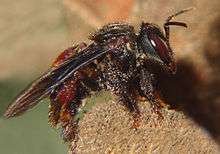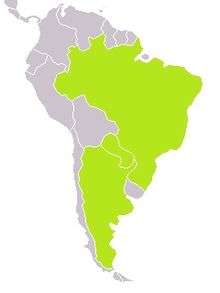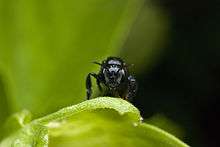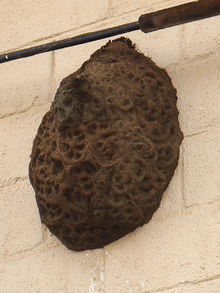Trigona spinipes
Trigona spinipes is a species of stingless bee. It occurs in Brazil, where it is called arapuá, aripuá, irapuá, japurá or abelha-cachorro ("dog-bee"). The species name means "spiny feet" in Latin. Trigona spinipes builds its nest on trees (or on buildings and other human structures), out of mud, resin, wax, and assorted debris, including dung. Therefore, its honey is not fit for consumption, even though it is reputed to be of good quality by itself, and is used in folk medicine. Colonies may have from 5,000 to over 100,000 workers.
| Trigona spinipes | |
|---|---|
 | |
| Scientific classification | |
| Kingdom: | Animalia |
| Phylum: | Arthropoda |
| Class: | Insecta |
| Order: | Hymenoptera |
| Family: | Apidae |
| Genus: | Trigona |
| Species: | T. spinipes |
| Binomial name | |
| Trigona spinipes (Fabricius, 1793) | |
 | |
| Found in parts of Brazil, Argentina, and Paraguay | |
| Synonyms | |
|
Trigona ruficrus Latreille, 1804 | |
T. spinipes will attack in swarms when they feel the nest is threatened. They cannot sting, and their bite is not very effective. Their main weapon against predatory animals, including human beings, is to entangle themselves in the victim's hair and buzz loudly. They will also aggressively penetrate human bodily openings such as nasal and auditory orifices when in attack mode.
T. spinipes uses odor trails, sometimes extending several hundred metres, in order to lead nestmates from the hive to a food source. Moreover, it can "eavesdrop" on chemical signals used by other bee species (such as carpenter bees, Africanized honeybees and other stingless bees) for the same purpose, killing them or driving them away to take over their food source.[1]
The bee has been considered an agricultural pest for some crops, such as passion fruit, because it damages leaves and flowers while collecting nest materials, and tunnels through the unopened flowers to collect the nectar (thus frustrating their normal pollinators).[2] On the other hand, they are significant pollinators on their own, e.g. for onions.[3]
Taxonomy and phylogeny
Trigona spinipes was described by Johan Christian Fabricius in 1793 but was known under Latreille's 1804 name Trigona ruficrus for many years; however, upon re-examination of a museum specimen, Jesus S. Moure determined that Trigona spinipes is the older name for the species.[4] Trigona spinipes is in the order Hymenoptera, which includes bees, wasps, ants, and sawflies. More specifically it is from the bee family Apidae, which contains well known bee genera such as honeybees (Apis) and bumblebees (Bombus). It is from the tribe Meliponini, which comprises all of the genera of stingless bees. The genus Trigona contains some of the most populous species among the stingless bees.[5]
Description and identification
Trigona spinipes constructs large external nests in trees. Compared to other Trigona species such as T. hyalinata, T. spinipes nests are built quite high above the ground.[6] They are usually built on forks between tree branches 4–7 meters from the ground and can be as large as 50–60 cm long and 50–60 cm wide.[4] The nest material consists of mud, wax, plant fragments, and resins.[7][8] The honeycombs within the nest contain the brood of eggs, larvae and pupae along within stores of honey and pollen.[8] Early studies of T. spinipes nests noted the presence of a dense internal structure referred to as the “scutellum” which was often used to paralyze fish because of its high content of acetylcholine. This dense structure consists of nest waste such as adult bee excrements and its primary role is suggested to be an internal support upon which honeycombs are built.[4] As for diet, Trigona spinipes has been known to collect pollen from a variety of plants, especially Eucalyptus spp., Aloe sp., and Archontophonix sp.[9]

Distribution and habitat
Trigona spinipes is quite common in large areas of Brazil as well as Paraguay, Argentina, and other parts of South America. It inhabits a variety of habitats including the cerrado (neotropical savannah), and tropical forests.[4][7] Studies concerning Trigona spinipes have largely been conducted in Eastern and Southeastern Brazilian states such as São Paulo, Alagoas and Minas Gerais.
Colony cycle

For Trigona spinipes, the act of colony initiation is not tied to changes in seasons – which are minimal in the tropic regions that it resides – but rather new colonies emerge as needed. Like other Meliponini bees, new Trigona spinipes colonies begin with swarms. Virgin queens emerge from the nests where they were born and fly with swarms of female workers to a new nesting spot. Drawn by an odor emitting from the virgin queen colony, males aggregate outside of the new nesting spot waiting for the queen to emerge. The queen then flies out for a single mating and returns to the nest.[10][11]
Within 6 months, a nest can reach full physical size.[4] In terms of number of bees,Trigona spinipes form some of the largest stingless bee colonies in the world, ranging in size from 5,000 to over 100,000 workers.[7] Some colonies can reach 180,000 individuals, which is one order of magnitude larger than the size of honey bee colonies.The nests are perennial.[12]
Behavior
Polarized odor-trail communication
Like all other stingless bees, Trigona spinipes is highly social. When foraging, the workers utilize polarized odor-trail communication to relay the locations of food sources to each other. Unlike classic pheromone trails which extend from the food source to the nest, these polarized pheromone signals are short and do not reach the nest. They likely evolved to be short so as to not lead eavesdropping predators back to their nest.[7] What makes these trails polarized is that they are strongest at the food source and taper off moving away from it. This allows other bees following the signal to arrive at the food in large numbers without wasting time looking for food along the trail.[7] Octyl octanoate is the most significant component of the trail pheromone. It is emitted from the cephalic labial glands of Trigona spinipes and makes up approximately 74% of the secretion. Studies found synthetically produced octyl octanoate to be equally attractive to natural extract derived from the labial glands of foragers.[5]
Male mating behavior
Because Trigona spinipes queens only mate once in their lifetimes, there is tremendous competition between males to copulate with virgin queens. Usually 30–50 but sometimes even hundreds of males can be counted near virgin queen colonies in lek-like groups. The males come from great distances and from a variety of nests. There is a very low probability that a male will ever mate. They stay inside the colony until the age of 2–3 weeks and then leave the nest and live the life of a solitary male bee, which might be 4–6 weeks. While living alone, they will forage with conspecific workers and may follow these workers back to their nests to learn the locations of conspecific nests.[10]
Communication
While Trigona spinipes workers follow their nest-mates pheromone trails to food resources, they have been shown to follow scent marks left by another stingless bee Melipona rufivertris. They do this when they are foraging for new sources of food. Afterwards, Trigona spinipes will attack foraging Melipona rufiventris bees and take over their food. Some hypothesize that honey bee dance evolved to prevent eavesdropping espionage of this sort.[7]
The pheromone signal laid down by Trigona spinipes have been found, surprisingly, to be a deterrent to the more dominant stingless bee species Trigona hyalinata. The reason for this is not clear, but it is hypothesized that the dominant specie wants to avoid costs and injuries associated with seizing a food source from Trigona spinipes rather than finding its own source.[13] Trigona hyalinata are attracted to food sources with fewer Trigona spinipes foragers, because they can easily overpower a small number of their competitors.[14]
Aggression
Trigona spinipes is locally known for its aggressiveness. Despite lacking the ability to sting, workers will pursue intruders and bite them. Each of their two mandibles have 5 sharp teeth. A study found that among 12 stingless bees investigated, Trigona spinipes was one of the 6 species that engaged in suicidal biting. The phenomenon of suicidal biting involved workers biting a target intruder so tenaciously that a significant number of the workers suffered fatal injuries. Of the 6 bees which engaged in suicidal biting, Trigona spinipes displayed the most aggressive behavior overall.[15]
Kin selection
Sex and caste determination
Sex in Trigona spinipes is determined by whether or not the eggs are fertilized. Fertilized eggs are diploid and become females while unfertilized eggs are haploid and become males. Caste determination is trophic, meaning that it is not hereditary, but rather depends on the quantity and quality of food consumed by larvae.[16] Female larvae which consume better and higher quality food develop 12 rather than the usual 4 ovarioles at the pupal stage which later develop into queens. This trophic caste determination is the reason that Trigona spinipes queens are larger than workers. There is no size difference between queens and workers in other Meliponini species which utilize trophogenic caste determination mechanisms.[17] Virgin queens pose a threat to established queens. They are usually not needed by the colony so they are usually either killed by workers or imprisoned.[18]
Workers laying eggs
Although they are smaller and have fewer ovarioles than queens, workers retain the ability to lay viable eggs. This ability is somewhat limited. Workers which are in close proximity to the queen often lay trophic or sterile eggs presumably due to hormone signals from the queen. In addition, the queen caste routinely consumes eggs laid by workers.[16]
Lack of polyandry
Unlike what might be expected for such large colonies, there is no polyandry or polygyny in Trigona spinipes, such as can be found in honeybees. The sperm limitation hypothesis for the evolution of polyandry postulates that polyandry – the behavior of a queen mating with multiple males – evolved partly as a way for the queen to obtain enough sperm to fertilize her eggs. A positive correlation has been found between polyandry and colony size across a variety of insects including ants, bees, and wasps. Polyandry also has the advantage of promoting genetic diversity in large colonies, which promotes disease resistance, as has been shown in other bee species that are usually monandrous.[19] As such, since Trigona spinipes are not polyandrous, the mechanisms by which they promote genetic diversity are not clear.[12]
Worker–queen conflict
The fact that Trigona spinipes colonies are headed by singly mated queens leads to conflict between workers and the queen over male production. Workers have the ability to lay unfertilized haploid eggs which will develop into males. Kin selection argues that it is in the workers favor to do this. This is because each worker is more related to her own sons (relatedness=0.5) than to the queen's sons (relatedness=0.25). In bee species such as honeybees, which are headed by polyandrous queens workers, workers are more related to the queen's sons (relatedness=0.25) than they are to each other's sons (relatedness = 0.125), so they consume each other's sons in a phenomenon known as worker policing. However, this is not the case in Trigona spinipes. There is ongoing conflict between queens and workers over egg laying with eggs constantly being consumed. This conflict may explain why Trigona spinipes, unlike honeybees, lay male and female eggs in identical cells. This makes it more difficult for workers to determine where the queen's male eggs are located.[18]
Human importance
Trigona spinipes serves as major pollinators of tropical plants, it pollinates a broad variety of species across South America and is considered the ecological equivalent of the honey bee.[12] However, Trigona spinipes has also be found to damage a variety of food crops while collecting nest materials. It has been shown to damage the fruits and flowers of rabbiteye blueberry plants, scarify the fruits of passion fruit, and damage broccoli floral stems.[8]
References
- James C. Nieh; Lillian S. Barreto; Felipe A. L. Contrera & Vera L. Imperatriz-Fonseca (2004). "Olfactory eavesdropping by a competitively foraging stingless bee, Trigona spinipes". Proceedings of the Royal Society of London B. 271 (1548): 1633–1640. doi:10.1098/rspb.2004.2717. PMC 1691773. PMID 15306311.
- Arlindo L. Boiça Jr.; Terezinha M. dos Santos & Jairo Passilongo (2004). "Trigona spinipes (Fabr.) (Hymenoptera: Apidae) em Espécies de Maracujazeiro: Flutuação Populacional, Horário de Visitação e Danos às Flores". Neotropical Entomology. 33 (2): 135–139. doi:10.1590/s1519-566x2004000200002.
- Maria C. A. Lorenzon, Ângelo R. Rodrigues, and João R. G.C. de Souza (1993). "Comportamento polinizador de Trigona spinipes (Hymeotpera: Apidae) na florada da cebola (Allium cepa L.) híbrida". Pesquisa Agropecuária Brasileira. 28 (2): 217–221.CS1 maint: multiple names: authors list (link)
- Nogueira-Neto, Paulo (1962-12-01). "The Scutellum Nest Structure of Trigona (Trigona) spinipes Fab. (Hymenoptera: Apidae)". Journal of the New York Entomological Society. 70 (4): 239–264. JSTOR 25005834.
- Schorkopf, Dirk Louis P.; Jarau, Stefan; Francke, Wittko; Twele, Robert; Zucchi, Ronaldo; Hrncir, Michael; Schmidt, Veronika M.; Ayasse, Manfred; Barth, Friedrich G. (2007-03-22). "Spitting out information: Trigona bees deposit saliva to signal resource locations". Proceedings of the Royal Society of London B: Biological Sciences. 274 (1611): 895–899. doi:10.1098/rspb.2006.3766. ISSN 0962-8452. PMC 2093984. PMID 17251108.
- Lichtenberg, E. M.; Imperatriz-Fonseca, V. L.; Nieh, J. C. (2009-12-18). "Behavioral suites mediate group-level foraging dynamics in communities of tropical stingless bees". Insectes Sociaux. 57 (1): 105–113. doi:10.1007/s00040-009-0055-8. ISSN 0020-1812. PMC 2803754. PMID 20098501.
- Nieh, James C.; Barreto, Lillian S.; Contrera, Felipe A. L.; Imperatriz–Fonseca, Vera L. (2004-08-07). "Olfactory eavesdropping by a competitively foraging stingless bee, Trigona spinipes". Proceedings of the Royal Society of London B: Biological Sciences. 271 (1548): 1633–1640. doi:10.1098/rspb.2004.2717. ISSN 0962-8452. PMC 1691773. PMID 15306311.
- Nunes dos Santos, Adrian Jorge (2011). "Stingless bees damage broccoli inflorescences when collecting fibers for nest building". Scientia Agricolta.
- Cortopassi-Laurino, M. & M. Ramalho (1988). "Pollen harvest by Africanized Apis mellifera and Trigona spinipes in Sao Paulo. Botanical and ecological views" (PDF). Apidologie. 19 (1): 1–24. doi:10.1051/apido:19880101.
- H.W. Velthuis, Hayo; Koedam, Dirk; L. Imperatriz-Fonseca, Vera (2005-01-01). "The males of Melipona and other stingless bees, and their mothers". Apidologie. 36 (2): 169–185. doi:10.1051/apido:2005014.
- Roubik, David W. (2006-01-01). "Stingless bee nesting biology" (PDF). Apidologie. 37 (2): 124–143. doi:10.1051/apido:2006026.
- Jaffé, Rodolfo; Pioker-Hara, Fabiana C.; Santos, Charles F. dos; Santiago, Leandro R.; Alves, Denise A.; Kleinert, Astrid de M. P.; Francoy, Tiago M.; Arias, Maria C.; Imperatriz-Fonseca, Vera L. (2014-01-26). "Monogamy in large bee societies: a stingless paradox". Naturwissenschaften. 101 (3): 261–264. doi:10.1007/s00114-014-1149-3. ISSN 0028-1042. PMID 24463620.
- Lichtenberg, Elinor M.; Hrncir, Michael; Turatti, Izabel C.; Nieh, James C. (2010-11-18). "Olfactory eavesdropping between two competing stingless bee species". Behavioral Ecology and Sociobiology. 65 (4): 763–774. doi:10.1007/s00265-010-1080-3. ISSN 0340-5443. PMC 3058493. PMID 21475736.
- King, Cynthia (2014-07-07). "Bee 'shouts' might evolve as more effective than 'whispers'". WSU News. Retrieved 2015-09-27.
- Shackleton, Kyle; Toufailia, Hasan Al; Balfour, Nicholas J.; Nascimento, Fabio S.; Alves, Denise A.; Ratnieks, Francis L. W. (2014-11-08). "Appetite for self-destruction: suicidal biting as a nest defense strategy in Trigona stingless bees". Behavioral Ecology and Sociobiology. 69 (2): 273–281. doi:10.1007/s00265-014-1840-6. ISSN 0340-5443. PMC 4293493. PMID 25620834.
- da Cruz-Landim, Carminada (2000). "Ovarian development in Meliponine bees (Hymenoptera: Apidae): the effect of queen presence and food on worker ovary development and egg production". Genetics and Molecular Biology. 23: 83–88. doi:10.1590/s1415-47572000000100015.
- Lisboa, L. C. O. (2005). "Effect of Larval Food Amount on Ovariole Development in Queens of Trigona spinipes (Hymenoptera, Apinae)". Anatomia Histologia Embryologia.
- Peters, John M.; Queller, David C.; Imperatriz–Fonseca, Vera L.; Roubik, David W.; Strassmann, Joan E. (1999-02-22). "Mate number, kin selection and social conflicts in stingless bees and honeybees". Proceedings of the Royal Society of London B: Biological Sciences. 266 (1417): 379–384. doi:10.1098/rspb.1999.0648. ISSN 0962-8452. PMC 1689682.
- Baer, B. & P. Schmid-Hempel (2001). "Unexpected consequences of polyandry for parasitism and fitness in the bumblebee, Bombus terrestris". Evolution. 55 (8): 1639–1643. doi:10.1554/0014-3820(2001)055[1639:ucopfp]2.0.co;2. PMID 11580023.
| Wikimedia Commons has media related to Trigona spinipes. |